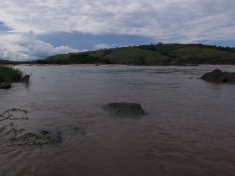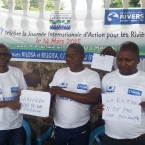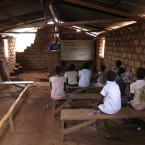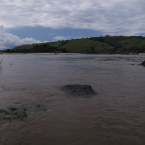Waiting For Electricity in the DRC
The People Need Electricity Now, Not in a Decade
The people of the DRC need power. And the government has chosen to build another big hydropower dam as the answer.
So now the Congolese people are waiting for electricity from the proposed Inga 3 Dam. But the billion-dollar question is: how long will it be before the Inga 3 Dam is actually built and supplying power? Who will the power be for? And most importantly, are there better options to power the country?
A year ago the World Bank committed US$73 million to finance social and environmental studies for the project. As of now, no studies have even begun. “The delays are related to the selection process for the lead consortium that will carry out the studies”, says Mr. Ntambwe, the financial and administrative Manager of the Inga 3 Project Management Unit (CGI 3). My partners and I understand that the number of bids received to conduct the studies was far higher than anticipated and that CGI 3 is taking their time to analyze all of them. Social and environmental impact studies for such large infrastructure projects usually take at least a year to complete – and even that is considered inadequate in places where there’s no baseline data to compare anything to, as in the DRC.
Last week, the World Bank announced another delay of Inga 3, projecting that construction would now begin in 2017, two years later than the DRC government’s projected start. While many issues still need to be resolved, the new projected date is provisionary and could be pushed back even further. For now, funding for construction has not been secured and the lead contractor that will manage construction will be required to help raise the required money – estimated to be US$14 billion. Fundraising for a project of this scale is not a mickey mouse task, as investors will need to be assured that their funds will yield healthy profits. With these latest delays, Inga 3 is on-track to meet the typical large-dam delay of 44%, as documented in a 2013 Oxford study.

And even when Inga 3 does begin producing power – projected to be 4,800 MW – it cannot meet the growing energy needs of this vast country. Mining interests in DRC have made an agreement with the government to purchase 1,300 MW from the dam. The government of South Africa has agreed to purchase 2,500 MW of the dam’s power – more than half of what will be produced by the first phase, Inga 3 Basse Chute (BC). The projected 1,000 MW to be sold from Inga 3 BC to DRC’s SNEL is not guaranteed, which means the Congolese people are last in line to receive energy produced at the expense of the health of their own river, and may be turned away empty handed.
The electricity will be sent to South Africa and the mines rather than the 63 million Congolese who live without electricity because the rural majority in Congo don’t live near the nation’s limited grid, and can’t afford to use enough of Inga’s electricity to make grid extensions worthwhile. Instead of investing in small-scale, decentralized renewable energy projects that could actually bring power to poor rural communities, once again, the electricity from an African dam has been sold to the highest bidder instead of being used for the greatest good.
National politics could also affect progress of this project. The DRC’s presidential and legislative elections are set for November 2016. Political instability is a major threat – the current incumbent, despite being constitutionally barred from seeking re-election, has indicated he intends to cling to power for an illegal third term. This has already created fear in the country that a new civil war may erupt if constitutional processes are ignored. Investors don’t like to pour money into unstable countries, and megaprojects like big dams can become political hot potatoes between rival political parties.
These risks make it more challenging for the Inga 3 project to secure funding, possibly delaying the start of construction beyond 2017. Even if the foundation stone is laid in 2018, the dam may only be completed in 2028. That’s a long time for Congo’s long-suffering people to remain in the dark.
Just like DRC, South Africa needs power now for its citizens and industry. That nation’s energy planners are not waiting around for Inga 3, arms folded, feet tapping impatiently. Instead, investment in clean energy like solar and wind has surged in South Africa to US $3.1 billion in 2015 from almost nothing in 2014, providing the quarter’s strongest growth in renewables.
If Inga 3 is built, it will not be this year or the year after. It will take at least 10 years for Kinshasa to see homes powered with electricity from this project. And at this rate it will take even longer – or a lifetime – for those who live outside Kinshasa to get electricity. But how long can a sick child in a hospital wait to obtain blood or medication? Without electricity, clinics cannot store blood or medicine. How long will students continue to use kerosene or candles for studying, and suffer the effects of inhaling high levels of pollution?
It’s time for the DRC to create and implement a plan to increase the national electrification rate by using renewable sources of energy – not continue relying on an outdated model of megaprojects and national grids that take decades to come online and bypass the poorest communities entirely. South Africa is not waiting for Inga 3. People in the DRC cannot afford to wait, either, while the rest of the world is moving forward.









